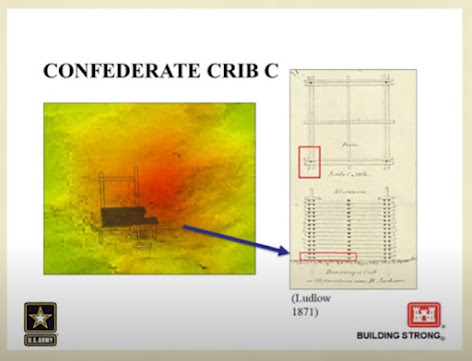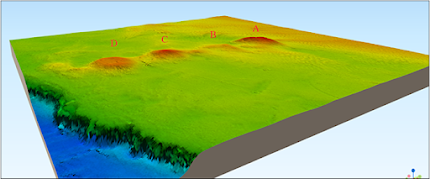 |
| Planks at the bottom of this obstruction are shown in dark area (USACE) |
Such was the
case in 2021, when they spotted 15 Revolutionary War-era cannons and explored obstructions placed in the river
85 years later during the Civil War.
Contractors
working for the US Army Corps of Engineers surveyed and dived two Confederate “cribs”
-- or tall wooden boxes filled mostly
with brick – that discouraged the approach of Union ships to the port city. Forces
towed the wooden obstructions, believed to be 40 feet by 40 feet, and put them
in place near Fort Jackson and the ironclad CSS Georgia, a floating battery
that was part of the Savannah River defenses.
Archaeologists last month provided details of the Revolutionary War and Civil War artifacts during a public event at the Savannah History Museum. Three cannons were recovered last year, while the other 12 were pulled up in January.
The Army Corps’ Savannah district funded the hard-hat dives as
part of the busy Georgia port’s channel deepening.
About a half dozen severely degraded cribs are on the South Carolina side of the river. Crews focused on what are called cribs C and D.
Commonwealth Heritage Group divers found some planks used
to build Crib C.
“On top of
the planks it was tons of bricks that we dug through, and then underneath the
planks it was sterile sand and Miocene clay, which is the base of the river,”
said archaeologist Stephen James. “That basically told us we were at the bottom
of the crib.”
They found an
intact corner at Crib D. While C won’t be impacted by the deepening, the
remnants of D were documented and then largely destroyed by dredging, James
said. “There is very little of the cribs left.”
The Confederacy used a wide array of weapons and obstructions to deter advances on Savannah from the sea. Besides forts and warships, wooden cribs, pile dams, torpedoes (mines), snags, logs and shipwrecks were employed.
 |
| Divers located an intact corner on this obstruction (USACE) |
After the
Civil War ended in 1865, the city wanted to reopen the port and it hired
salvage companies to remove river obstructions, including the cribs and pieces
of the scuttled CSS Georgia.
“They had
their own demolition. Surprisingly, they had divers back then, had pretty
heavy-duty machinery to pull that stuff down,” said Will Wilson of Commonwealth
Heritage Group. Of course, not all of the objects were removed or recovered in the 19th century.
 |
| Topographic view of four cribs from survey. Dredged channel is in blue (USACE) |
Officials referred to period maps and descriptions from Union Corps of Engineers Capt. William Ludlow and a Capt. Boutelle for information on the cribs.
The CSS Georgia is on the National Register of Historic Places and the cribs are eligible for inclusion, officials say.
Phil, where are all those cannons now?
ReplyDeleteThe Corps, I believe, has custody as decisions are made on possible conservation.
ReplyDelete